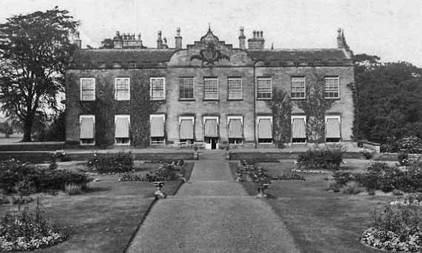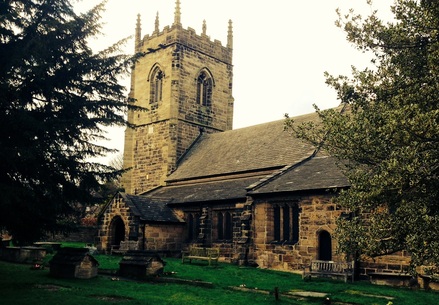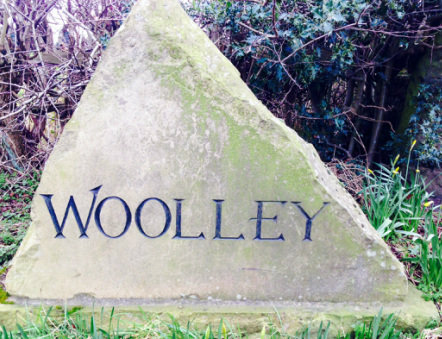Woolley village is situated on the south side of Wakefield district, West Yorkshire, midway between the city of Wakefield to the north and Barnsley to the south. The western boundary roughly follows the river Dearne, which is no more than a large stream at this stage, with the eastern boundary formed by the A61 highway between Wakefield and Barnsley.
The village has always been predominantly agricultural and would appear to have benefited in many respects from the shelter provided by the Woolley Edge escarpment.
Sited in the West Yorkshire coalfield, until recently the surrounding neighbourhood's industry was predominantly coal mining. The largest mine was Woolley Colliery, on the village's southern fringe, where as many as 2000 men were employed at its peak in the 1950s. Coal was produced here for more than a century until the last working mine was closed in the 1980s. The other highly productive mine was at Haigh.
Today there is little evidence of either colliery. A large housing development, known as Woolley Grange, has been built on the site of Woolley colliery.
Woolley village lies on the east side of the rising ground which slopes up to Woolley Edge. It is recorded in the Doomsday book as 'Wiluelai', at a time when there was virtually no cultivation and was held by the Saxon Turchill. The surrounding land was once the home of fierce wild animals and the very name of 'Woolley' is derived from the old English description of a wolves' shelter, 'Wulf-laye'.
Woolley has been essentially a farming community, and following its purchase in 1599 by Michael Wentworth, it became part of the Wentworth estate.
The village has always been predominantly agricultural and would appear to have benefited in many respects from the shelter provided by the Woolley Edge escarpment.
Sited in the West Yorkshire coalfield, until recently the surrounding neighbourhood's industry was predominantly coal mining. The largest mine was Woolley Colliery, on the village's southern fringe, where as many as 2000 men were employed at its peak in the 1950s. Coal was produced here for more than a century until the last working mine was closed in the 1980s. The other highly productive mine was at Haigh.
Today there is little evidence of either colliery. A large housing development, known as Woolley Grange, has been built on the site of Woolley colliery.
Woolley village lies on the east side of the rising ground which slopes up to Woolley Edge. It is recorded in the Doomsday book as 'Wiluelai', at a time when there was virtually no cultivation and was held by the Saxon Turchill. The surrounding land was once the home of fierce wild animals and the very name of 'Woolley' is derived from the old English description of a wolves' shelter, 'Wulf-laye'.
Woolley has been essentially a farming community, and following its purchase in 1599 by Michael Wentworth, it became part of the Wentworth estate.

Woolley Hall is a Grade II* Listed Building and was the home of the Wentworth family for centuries. It is an example of early Jacobean architecture. Its construction began around 1635 and it was added onto at the turn of the 19th century by the architect Jeffrey Wyatville.
In 1947, the Hall was sold to the local Council. It was subsequently used as a College of Further Education then more recently as a Wedding and Conference venue. The building and land are currently not in use and are for sale by Wakefield Council.
In 1947, the Hall was sold to the local Council. It was subsequently used as a College of Further Education then more recently as a Wedding and Conference venue. The building and land are currently not in use and are for sale by Wakefield Council.
In the early 20th Century the village was like a part of the Wentworth family. A member of the family was quoted as saying 'a great many of the maids at the Hall married farmers and the lives of the village people were all interwoven with ours'.
At that time, as many as 43 staff were employed at Woolley Hall and most probably most village residents depended on the Hall for their livelihood, with possibly some working in local mines and others in the farms.
Most of the older houses in the village are of stone with flagged roofs. many of which have been given a Grade 2 Listed Building status. The outline of the village has not changed much over the years.
Woolley village is now in a conservation area, in order to try to preserve its characteristics and the integrity of its original buildings. The village Post Office has long gone, and there are neither shops nor pubs in the village.
In 1800, there were 3 alehouses in Woolley. The last of these, which was known as the 'Wentworth Arms', was closed by the squire more than 100 years ago. It was deemed by him as an improvement.
At that time, as many as 43 staff were employed at Woolley Hall and most probably most village residents depended on the Hall for their livelihood, with possibly some working in local mines and others in the farms.
Most of the older houses in the village are of stone with flagged roofs. many of which have been given a Grade 2 Listed Building status. The outline of the village has not changed much over the years.
Woolley village is now in a conservation area, in order to try to preserve its characteristics and the integrity of its original buildings. The village Post Office has long gone, and there are neither shops nor pubs in the village.
In 1800, there were 3 alehouses in Woolley. The last of these, which was known as the 'Wentworth Arms', was closed by the squire more than 100 years ago. It was deemed by him as an improvement.

St Peter's Church, Woolley is a beautiful mediaeval church with examples of late mediaeval stained glass windows. It serves the parishioners of Woolley, West Bretton and Haigh and, for centuries, has welcomed people to worship God, to celebrate Christian festivals and to commemorate life's events.
During the year, there are social activities not only for the congregation of St Peter's but for all residents, bringing together the whole community in a lighthearted atmosphere. Everyone is welcome to join in.
For further information, visit St Peter's Church's website http://www.woolleychurch.org.uk
During the year, there are social activities not only for the congregation of St Peter's but for all residents, bringing together the whole community in a lighthearted atmosphere. Everyone is welcome to join in.
For further information, visit St Peter's Church's website http://www.woolleychurch.org.uk

Woolley Parish Council sets the annual budget and ensures that the money is spent for the benefit of the Parish.
The Council usually meets on the second Thursday each month, except in August. Meetings commence at 7.30pm with a 15 minute session for members of the public to raise any concerns they may have.
Meetings are held in Woolley Village Hall, The Green, Woolley.
The Parish Council advertises its meetings on the notice boards in Woolley (The Green), Haigh (Memorial Garden)
and Woolley Grange. Everyone is welcome to attend.
For further information, visit The Parish Council's website http://woolleypc.org.uk
The Council usually meets on the second Thursday each month, except in August. Meetings commence at 7.30pm with a 15 minute session for members of the public to raise any concerns they may have.
Meetings are held in Woolley Village Hall, The Green, Woolley.
The Parish Council advertises its meetings on the notice boards in Woolley (The Green), Haigh (Memorial Garden)
and Woolley Grange. Everyone is welcome to attend.
For further information, visit The Parish Council's website http://woolleypc.org.uk
Local Places of Interest
The village of Woolley is picturesque, tranquil and surrounded by fields and woodlands, with many public
footpaths offering the opportunity to explore and discover the delights of our local countryside.
On our doorstep there is Woolley Park Golf Club, one of West Yorkshire's premier golf clubs. Owned and managed by a family who have lived in Woolley for 4 generations, Woolley Park Golf Club offers a warm welcome and challenging golf. It is open for golf from 7am until dusk and the fully licensed bar is open from 10am, closing when the last customer leaves. Woolley Park's two resident chefs serve local food daily between the hours of 9am and 5pm.
For further information, visit Woolley Park Golf Club's website http://www.woolleyparkgolfclub.co.uk
Seckar Wood, nestling on the edge of Woolley village, is an ancient woodland and lowland heathland. Seckar Wood was part of the Wentworth estate for over 300 years, until 1923 when it was bought by local photographer, Warner Gothard. The walled pond near the centre was built as a swimming pool in the 1930s and the small summer house nearby was never completed. Warner died in 1940 and left the wood to the people of Wakefield and Barnsley. Seckar Wood is treasured for its peace and tranquility and was designated a special site of scientific interest due to the diversity of the plants found there.
For further information, visit Wakefield Council's website
http://www.wakefield.gov.uk/residents/sport-and-leisure/parks-and-countryside/parks/seckar-wood
Within easy reach of Woolley village are many places of natural beauty offering a variety of things to do, including
The village of Woolley is picturesque, tranquil and surrounded by fields and woodlands, with many public
footpaths offering the opportunity to explore and discover the delights of our local countryside.
On our doorstep there is Woolley Park Golf Club, one of West Yorkshire's premier golf clubs. Owned and managed by a family who have lived in Woolley for 4 generations, Woolley Park Golf Club offers a warm welcome and challenging golf. It is open for golf from 7am until dusk and the fully licensed bar is open from 10am, closing when the last customer leaves. Woolley Park's two resident chefs serve local food daily between the hours of 9am and 5pm.
For further information, visit Woolley Park Golf Club's website http://www.woolleyparkgolfclub.co.uk
Seckar Wood, nestling on the edge of Woolley village, is an ancient woodland and lowland heathland. Seckar Wood was part of the Wentworth estate for over 300 years, until 1923 when it was bought by local photographer, Warner Gothard. The walled pond near the centre was built as a swimming pool in the 1930s and the small summer house nearby was never completed. Warner died in 1940 and left the wood to the people of Wakefield and Barnsley. Seckar Wood is treasured for its peace and tranquility and was designated a special site of scientific interest due to the diversity of the plants found there.
For further information, visit Wakefield Council's website
http://www.wakefield.gov.uk/residents/sport-and-leisure/parks-and-countryside/parks/seckar-wood
Within easy reach of Woolley village are many places of natural beauty offering a variety of things to do, including
- Yorkshire Sculpture Park http://www.ysp.co.uk
- Newmillerdam Country Park http://www.wakefield.gov.uk/residents/sport-and-leisure/parks-and-countryside/parks/newmillerdam-country-park
- Pugneys Watersports Centre and Country Park http://www.wakefield.gov.uk/residents/sport-and-leisure/pugneys-watersports-centre-and-country-park
- Anglers Country Park http://www.wakefield.gov.uk/residents/sport-and-leisure/parks-and-countryside/parks/anglers-country-park






